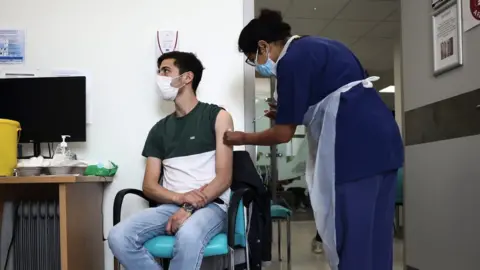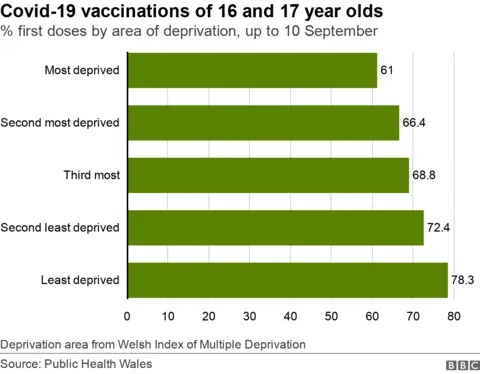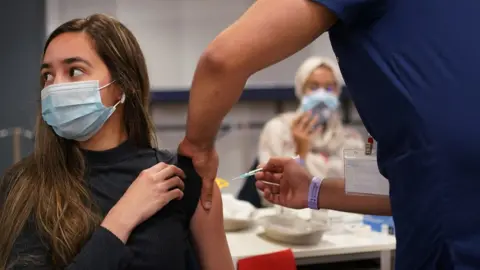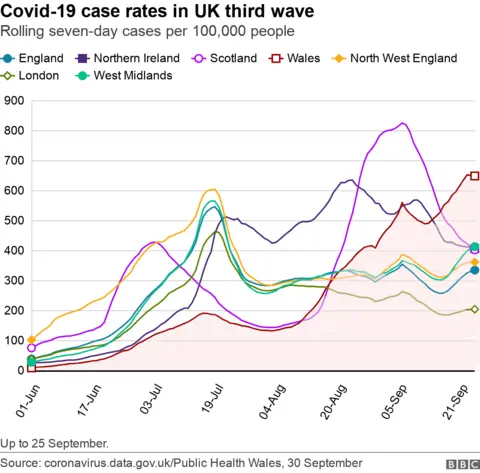Covid: Jab uptake gap between affluent and deprived teens
 Reuters
ReutersSixteen and 17-year-olds are far more likely to take up the offer of a Covid vaccine in more affluent parts of Wales than they are in more deprived areas.
Public Health Wales (PHW) figures showed 61% had been given a first dose of a jab in the most deprived areas of Wales - compared with 78.3% in the least deprived areas.
Vaccine offers were made to all 16 and 17-year-olds six weeks ago.
Up to Tuesday night, 71.2% had received a first dose.
It is the first time a breakdown of teenage uptake has been available in terms of gender, economic background and ethnic group.

Up to 10 September, there were 3,449 young people in the poorest areas yet to receive a first dose.
When looking at the uptake among that age group by sex, girls are ahead at 70%, with boys at 66.4%.
 PA Media
PA MediaThere is a far smaller gap between 16 and 17-year-olds from black, Asian and minority ethnic (BAME) backgrounds and their white counterparts - 8.8 percentage points.
The widest gap among BAME age groups is for those in their 30s, where 64% have so far had a first Covid vaccine dose, compared with 80.7% of white people in their 30s.
PHW produces a monthly analysis of how the vaccine programme is reaching different groups in Wales.
'High risk' schools
Meanwhile, teachers in Cardiff and the Vale of Glamorgan have been told to wear face coverings when moving around indoor communal areas
Vale of Glamorgan council said the Cardiff and Vale region was "in the high risk category", due to increasing cases in older people, increasing hospital admissions and pressure on the Test, Trace and Protect service locally.
It also said schools in the area should make lateral flow tests available to staff twice a week.
The measures will be in place until the October half-term, before being reviewed.
Pembrokeshire school pupils aged 10 to 19 over the last 30 days have had more than 200 cases, councillors in the area have been told.
Director of education Steven Richards-Downes warned there was an increasing risk of year group closures due to Covid with one secondary school already having to take that step due to staff absences caused by illness, self-isolating and other reasons, according to the Local Democracy Reporting Service.
Ensuring a balance between well-being, a more normal school environment and reducing Covid risks was needed, added Mr Richards-Downes, with "most cases from social contacts outside schools".
He said, particularly for teenagers in their "formative years", the challenge was to "balance the harms of restricting contact and making sure learners are in a space where they can do the kinds of things they would normally do".

What do the latest figures tell us?
In Wales, 648.1 people per 100,000 population have had a positive Covid test in the past seven days.
That is a a slight fall for a second successive day.
The daily average number of cases is 2,919 - up from 2,529 a week ago, although the recent rise has been slowing down.
Neath Port Talbot is still the local authority area with the highest case rate (935.7 per 100,000) although this has fallen slightly.
It has the second highest case rate in the UK and six Welsh council areas are in the highest 10 in the UK, although case rates in England are starting to rise again.
Wales continues to have the highest case rate out of all UK nations and regions
PHW figures show 59% of positive tests in Wales were in the under-30 age group, with 40% among 10 to 19-year-olds.
We have also seen record numbers of positive lateral flow test results in the last week - with 51% or nearly 2,000 involving asymptomatic young people - which, if followed up with positive PCR tests, will have swelled the case numbers we are seeing.
There were 13 deaths with Covid-19 reported by PHW on Thursday, all of which occurred on Wednesday.
There have been 37 deaths in the past seven days, an average of 5.3 a day.
Four of Wednesday's deaths were reported in the Aneurin Bevan health board area, three in Cardiff and Vale, two in Betsi Cadwaladr, one in each of the Cwm Taf Morgannwg, Hywel Dda and Swansea Bay health board areas, with one outside Wales.
Meanwhile, the first death involving Covid in a child in Wales was registered in the week up to 17 September - a girl aged 14 or under - in Public Health Wales' analysis of latest Office for National Statistics mortality figures.
The key indicators around the impact on hospitals show numbers of patients with confirmed Covid has fallen for a ninth successive day. The average - 440 patients - is the lowest for 16 days.
Covid admissions are still well below levels we saw during the second wave although the daily average is up to 36. There were 52 new confirmed and suspected hospital admissions on Wednesday, the highest daily figure for 11 days - 17 of them in Cwm Taf Morgannwg.
